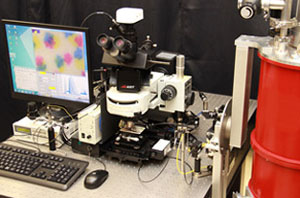News
AIST Develops Photon Microscope Which Can Observe a Single Photon Updated in July 2017
National Institute of Advanced Industrial Science and Technology (AIST) recently announced that they developed a photon microscope which can observe a photon, the smallest measurable unit of a light.For the first time, they succeeded to detect an extremely weak light and to observe its color image which was impossible with conventional optical microscopes.The research results were published on a British science journal.
https://www.nature.com/articles/srep45660
In the past, AIST’s Physical Measurement Standards Research Section, Quantum Optical Measurement Group (Leader: Daiji Fukuda) has developed an optical sensor that can detect and extract each photon by applying superconductivity.The optical sensor can also identify the wavelength of photons.The research group developed the photon microscope by using this sensor as the microscope’s photodetector.Photon wavelengths are closely related to colors, and there is a correlation between wavelength and photon energy.Therefore, the team applied this principle of being able to recognize each photon’s wavelength and color by measuring its energy.
Electronic microscopes are widely used to observe tiny test samples, but its observation image was monochrome (black and white).Moreover, conventional photon microscopes could not detect extremely faint light consisting of just a few photons. It was not possible to photograph color images of test samples.
According to the research group, photon microscopes will not only enable observation of faint luminescence by living cells, but will allow fluorometric analysis of chemical substance traces.Consequently, the photon microscope can be expected to be used for R&D and product development in medicine, biotechnology and semiconductors.
https://www.ibtimes.com/human-eye-can-detect-even-individual-photons-smallest-unit-light-study-2393524

Photos courtesy of Japan Science and Technology Agency







